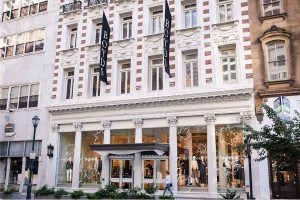How Did the Constitution Center Become a Monument to Mediocrity?
It’s Flag Day, June 14th, and I have the National Constitution Center nearly to myself.
Inside the museum’s core exhibit, The Story of We the People, a sweeping circular collection of multimedia displays and whizbang gadgetry—“the Star Trek thing,” as Joseph Torsella, the center’s president from 1997 to 2003 and again from 2006 to 2009, describes it—there’s but a smattering of elderly people and teenagers on chaperoned day trips. They meander about the American National Tree, a seemingly infinite array of touch-screen vignettes on American notables (César Chávez, Larry Flynt, John Rockefeller); have themselves videotaped taking the presidential oath of office; and watch Nixon speechwriter Ben Stein’s kaffeeklatch Q&A on the Constitution’s glories on a projector screen. I’m later told that if you fully explored every one of the hundred or so display screens and History Channel-produced video shorts in this hall, you’d be here for 17 hours. I made it through in about 25 minutes.
Around the corner is Signers’ Hall, where the Constitution’s framers are depicted as pensive life-sized bronze statues, debating in an erudite,gentlemanly manner the issues of the day. In an overlooked alcove is one of the center’s few artifacts, a barely legible early printing of the Constitution from the Pennsylvania Gazette.
The centerpiece of this hall—this museum, really-is a carefully choreographed one-actor show called Freedom Rising, a 17-minute retelling of how the Constitution came to be. Paintings of colonists and photos of iconic moments in American history are splashed onto the 360-degree theater’s- walls and floor and screens that descend from the ceiling. It all crescendos in a soaring, if overwrought, exhortation to be grateful for our freedoms. This is, far and away, visitors’ favorite attraction.
“Being uplifted and feeling pride is among the best experiences you can have,” Constitution Center president and CEO David Eisner says on July 6th, two days after its eighth anniversary and this country’s 235th birthday. “I defy you to find a roller coaster that when people get off it, they feel as good as they feel at the end of Freedom Rising.”
To me, it felt more fifth-grade social studies than Six Flags. In fact, that’s an apt description of my whole Constitution Center experience: rudimentary history with a gloss of patriotism, sugarcoated for easier digestion.
In mid-July I spent a muggy Sunday playing tourist in Washington, D.C., Philly’s main historical tourism competitor, taking in the Smithsonian’s vast National Museum of American History and the National Archives’ vault-like Rotunda, where the original Constitution, Declaration of Independence and Bill of Rights are housed.
But the highlight of my trip was, without reservation, the Newseum, a seven-story, $450 million facility that opened in 2008 as a celebration of the free press. From its dazzling glass-and-steel architecture to its 14 exhibit galleries and 15 theaters, from the collection of Berlin Wall pieces to the massive 31-foot-tall 9/11 memorial, from the 8,000-plus artifacts to the kid-friendly interactive displays to the heart-wrenching wall of Pulitzer Prize-winning photography, the Newseum is exactly what a museum should be: provocative, compelling, dramatic, beautiful. In comparison, the Constitution Center looks woefully small—almost inconsequential.
As I hopped in a cab back to Union Station that afternoon, I was haunted by one thought: The Constitution Center sucks.
UPON REFLECTION THAT’S NOT entirely fair.
In some respects, the Constitution Center has been quite successful. It regularly features top-shelf speakers and issue panels. Every September, it awards the Liberty Medal—this year, to former Defense Secretary Robert Gates; in years past, to Tony Blair, Steven Spielberg and Bono. It has hosted big-name debates, most notably between Hillary Clinton and Barack Obama in 2008, and Obama’s famous race speech earlier that spring. Bill Clinton heads its board of trustees. George H.W. Bush held that post before him.
You’d think, then, that the $185 million Constitution Center would be an indelible Philadelphia institution. It’s not. It hasn’t produced an appreciable spike in tourism, or boosted the city’s national clout in any discernible way. Instead, the center’s museum is an afterthought—an inexpensive way to catch a break from the summer heat after you’ve toured Independence Hall and snapped a photo of the Liberty Bell.
Eight years on, the Constitution Center feels like a missed opportunity.
The center knows it has a problem. This month it will unveil a new marketing strategy, aimed at letting tourists know that: a) it exists; and b) coming here will make you feel good about America. Eisner, who became CEO in December 2009, has a PR background, so it’s no coincidence that under his watch the center is launching its first real branding initiative. “We get A-plus grades for content,” he says, “and gentlemen’s passing scores for distribution.”
But maybe when you’re a hammer, everything looks like a nail. Maybe, considering what constitutes that “A-plus” content—the middling Freedom Rising; this summer’s underwhelming feature exhibit, Spies, Traitors and Saboteurs: Fear and Freedom in America, which had all the intrigue of a basic-cable documentary on space aliens building the Egyptian pyramids; 2009’s plea for attention, Diana: A Celebration, an exhibit (in the Constitution Center, no less) about a deceased British ex-royal—something else is amiss.


